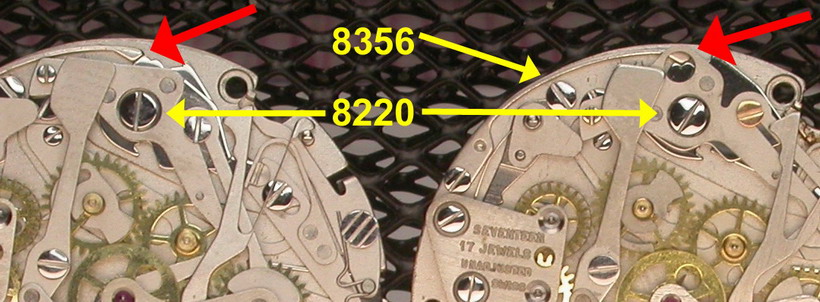| Informational Websites | ChronoMaddox -- the legacy of Chuck Maddox | OnTheDash -- vintage Heuer website | Zowie -- Omega information |
| Discussion Forums | ChronoMaddox Forum | Heuer Forum | Omega Forum |
| Counterfeit Watchers | ChronoTools Forum | ChronoTrader Forum |
|
|
The largest independent, non-commercial, consumer-oriented resource on the Internet for owners, collectors and enthusiasts of fine wristwatches. Online since 1998. | |||||||
|
||||||||
|
||||||||
 |
Vintage Heuer Discussion Forum
The place for discussing 1930-1985 Heuer wristwatches, chronographs and dash-mounted timepieces. Online since May 2003. | ||||||
| |||||||
| |||||||

This 24229x Autavia (shown above) is an interesting one to study. Yes, it looks like a Caliber 12 movement, but you will notice that the big hammer at the top of the photo (8220) is the style of the Caliber 11 and Caliber 11-I, and not the style of a Caliber 12 hammer [see the photo below, where we compare the hammers]. Here is what we say about this hammer:
In the Caliber 11 and 11-I movements, the hammer cam jumper (8356) rested against the lower section of this hammer (8220), but there was nothing to prevent the hammer cam jumper (8356) from "jumping" out of position, coming to rest above the hammer (8220), which would result in the start / stop / reset being inoperable. In the Caliber 12 movement, the "head" of the hammer (8220) was made significantly larger, so that it "sandwiched" the hammer cam jumper (8356) in place and prevented it from jumping out of position. A large hole in the head of the hammer (8220) allows for oiling of the area of contact between the jumper and the hammer, and is an easy way to identify a Caibler 12 movement.
So this movement, though it is marked Caliber 12 and has the gold-tone plates, may represent something of a transitional movement, between the Caliber 11-I and the Caliber 12. Perhaps most of the components are Caliber 12, but it still has this "leftover" hammer from Caliber 11-I. I have seen this exact same configuration before, in a 2409xx watch . . . movement was gold tone and marked Caliber 12, but it had the old style hammer (8220) . . . and, yes, it had the arrows on the case.
Perhaps at this time (with the 240xxx to 242xxx serial numbers), Heuer was transitioning to the Caliber 12 movement, with the gold tone plates, and the Caliber 12 marked on the chronograph bridge (8500), but the improvements in the movement were not yet completed (so we see the old-style hammer).
So I am still not convinced that we have seen a fully-developed, standard-issue Caliber 12 movement, in a case with the arrows on the lugs. I believe that these standard-issue production Caliber 12 movements would have a later serial number.
Of course, there is another explanation: That Heuer had lots of these cases, with the arrows already marked, and they continued to use them up on their production watches, even after they had moved from Caliber 11-I to Caliber 12. This is a simple explanation, and we know that the simplest explanations are often best.
Jeff

+++++++++++++++++++++++++++++++++++++
: That's another great explenation Jeff !
: but I have still a problem ...
: two watches
: one with this number 24188x
: one arrow cal 12
: 
: 
: the second with this number 24229x
: two arrows cal 12
: 
: 
: what's your opinion?
: ciao
: A.
| Chronocentric and zOwie site design and contents (c) Copyright 1998-2005, Derek Ziglar; Copyright 2005-2008, Jeffrey M. Stein. All rights reserved. Use of this web site constitutes acceptance of the terms of use. | CONTACT | TERMS OF USE | TRANSLATE |